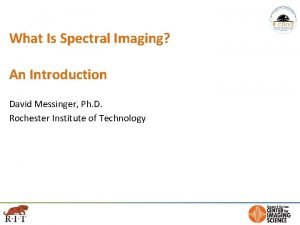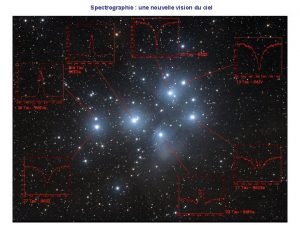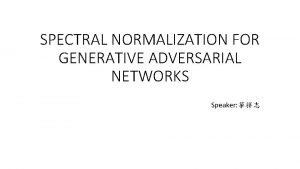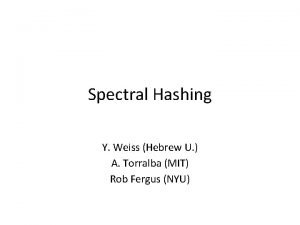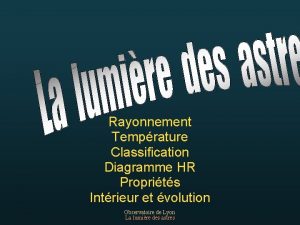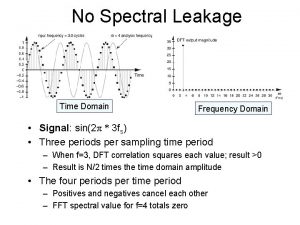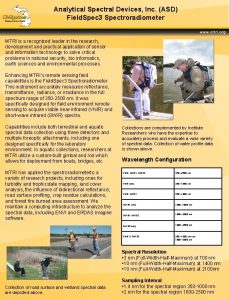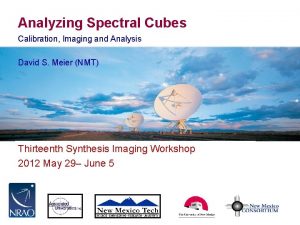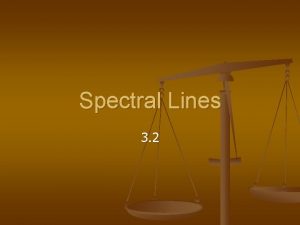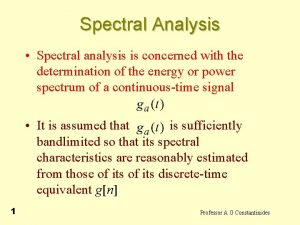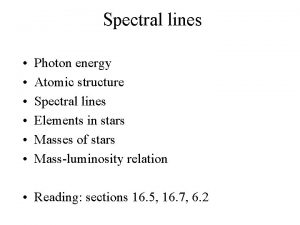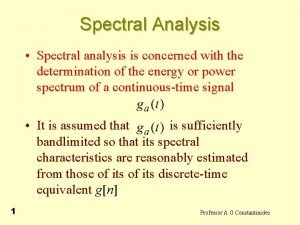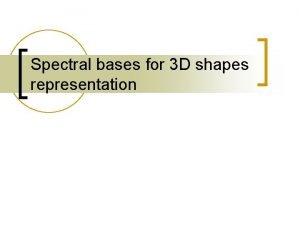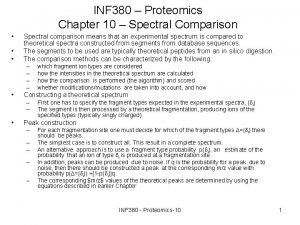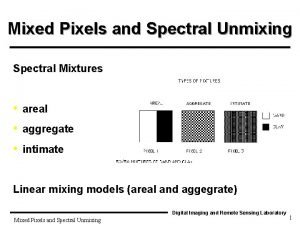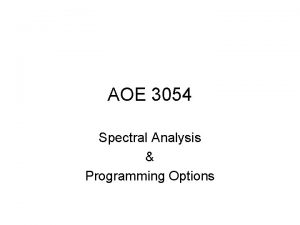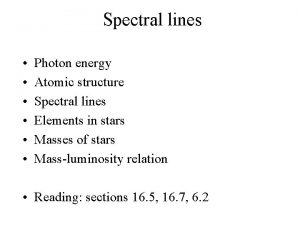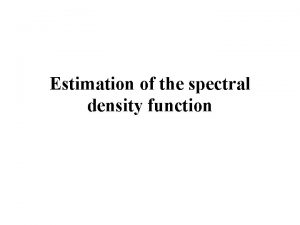What Is Spectral Imaging An Introduction David Messinger

























- Slides: 25

What Is Spectral Imaging? An Introduction David Messinger, Ph. D. Rochester Institute of Technology

What is Spectral Imaging? • Over time (passive) imaging systems have improved their spectral (i. e. , color) response, range, and sensitivity – – B&W (1 spectral band) Color (RGB, 3 spectral bands) “Multispectral” (typically a filtered or colored illumination system) “Hyperspectral” (use of a diffraction element such as a prism or grating) • Why more bands? – more spectral information leads to greater material separability 2

Basic Outline of Talk • Definitions: light, wavelength, and color • Overview of imaging systems – – What the camera sees How to collect color imagery Difference between multi- & hyperspectral Calibration, registration • Basic image processing concept – Spatial processing – Spectral processing • Questions 3

Definitions • Wavelength: related to the energy of light and color; typically written as l 4

Definitions • Color: optical property of materials; how it selectively reflects light • Reflectance: efficiency with which an object reflects light as a function of wavelength • Fluorescence: material property by which light is emitted at a different wavelength that it is illuminated with • Spectral band / channel: a specific color in an imaging system • Resolution: the projected area of each pixel on the detector onto the object • Spectral response: how sensitive the detector is to each wavelength of light 5

Imaging System: What the Camera Sees light source camera Reflectance vs. Transmission vs. Fluorescence Table to hold object

Imaging System: Your Cell Phone light source camera Placed in front of camera detector notional “Bayer” pattern for RGB digital camera Table to hold object

Imaging System: Filter Wheel light source camera Placed in front of camera and rotates Table to hold object

Imaging System: Colored Illuminant camera color of light source is modified Must be done in the dark! Table to hold object

Multi- vs. Hyper- Spectral • My definitions • MSI – Spectral imaging system that uses filters or colored illumination – Generally has 10’s of spectral bands without continuous spectral coverage – Generally has higher spatial resolution • HSI – Uses a dispersion element to project “rainbow” onto detector – Either the object or the camera has to move – Produces continuous spectrum per pixel – Generally lower spatial resolution 10

Basic Hyperspectral Imaging System • For spectroscopy, we need to spread the light out using a diffraction grating or a prism • Image is collected one line at a time, but full spectral information is collected for each line on 2 D array • Second spatial dimension collected by platform or object motion 1 D collection aperture 11 2 D detector array

Calibration • Camera records digital counts – raw data • Can be converted to radiance (physical units) with calibration coefficients • Can be converted to reflectance with known target in scene • Different from color balancing 12

Image Registration Two images of same object at different wavelengths but slightly offset Images simply overlaid in pixel space Images registered by content

Spatial Image Processing • Uses information contained in the spatial domain – Pixels are next to each other • Typically (but not always) done on a single band image • Examples – Sharpening and filtering, attempting to remove blur – Edge detection 14

Spatial Image Processing RGB from hyperspectral PC band 1 High Pass Filtered 15

Spectral Imaging Processing: Signatures • The actual measurement in each band • How “bright” is this object in this band relative to the other bands? • Useful for identifying bands of high contrast and for assessing spectral similarity 16

Hyperspectral Pixel Signatures Spectral measurement (reflectance) as a function of wavelength for three different materials 17

Spectral Signatures in the Color Space • We think of pixels as points in a space where the axes are the various colors blue • Specific colors fall on the axes, mixtures fall in the space in between red • Provides a mathematical description of the data that is useful green 18

Principal Components Analysis (PCA As seen from the blue axis: difficult to separate blue • Consider this collection of pixels in two colors • They represent two different materials, but their color differences are subtle • Looking at them in either red or blue alone makes it difficult to distinguish red As seen from the red axis: difficult to separate

Principal Components Analysis (PCA) • PCA provides a way to represent them with new axes • New axes are derived to maximize separation in first PCA dimension (band) • Now materials are easy to separate new PCA axis 2 blue Points are now easy to separate in PCA band 1 new PCA axis 1 red 20

Principal Components Analysis (PCA) • What’s that weird plot ENVI gives me when I run PCA but before I see my result? • The “eigenvalues”: numbers that describe the amount of variability in each new band • When they go to zero there isn’t any more information contained • Related to the material diversity in the scene 21

Spectral Similarity Measures • We measure how similar pixels are to each other based on their spectral similarity • Pixels of similar material will have similar spectral signatures – And will appear of similar color in original image and in transformed images such as PCA • Spectral angle is one measure, but there are others – In the case of spectral angle, smaller values indicate more similar 22

Spectral Similarity Measures blue pixels treated as vectors in color space red green Angle between two vectors is a measure of color similarity

Other tasks • Target detection – “known signature detection” – If I have an exemplar of what I’m looking for, assess how likely every other pixel is to be the same material • Anomaly detection – Find pixels that are anomalous, or somehow different • Classification – Label each pixel as belonging to one of n classes – Can be done automatically or through training data 24

Questions? David Messinger messinger@cis. rit. edu https: //xkcd. com/1688/ 25
 Spectral imaging
Spectral imaging David messinger rit
David messinger rit Frc control system
Frc control system Daniel messinger
Daniel messinger Sciclogy
Sciclogy Bruce messinger
Bruce messinger Daniel messinger
Daniel messinger Daniel messinger
Daniel messinger A brief introduction to spectral graph theory
A brief introduction to spectral graph theory Spectral regrowth
Spectral regrowth Spectral regrowth
Spectral regrowth Spectral classification
Spectral classification Profil spectral rigel
Profil spectral rigel Spectral normalization gan
Spectral normalization gan Spectral hashing
Spectral hashing Spectral efficiency
Spectral efficiency Domaine spectral
Domaine spectral Spectral leakage
Spectral leakage Spectral bands
Spectral bands Spectral clustering
Spectral clustering Spectral clustering
Spectral clustering Foster freeman vsc 80
Foster freeman vsc 80 Spectral clustering
Spectral clustering Spectral characteristics of angle modulated signals
Spectral characteristics of angle modulated signals Analytical spectral devices
Analytical spectral devices Theorem
Theorem

